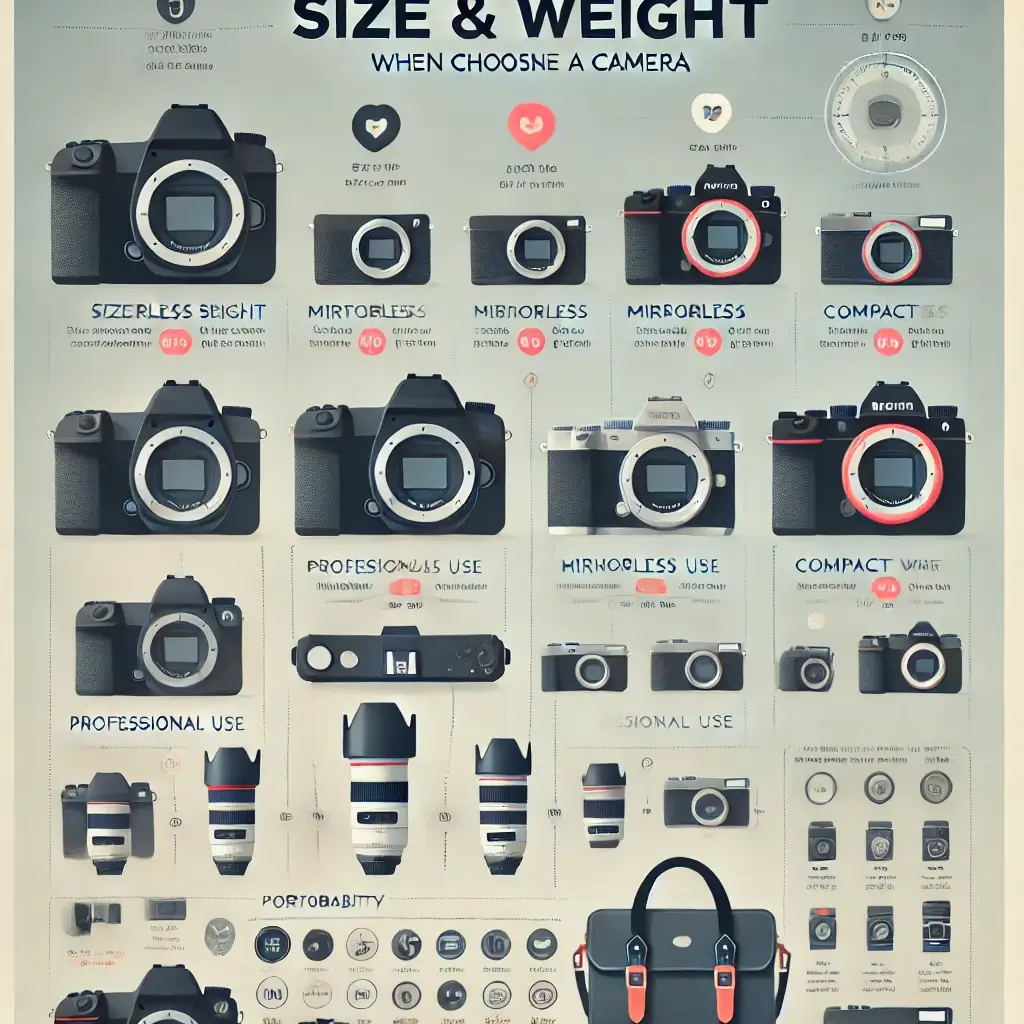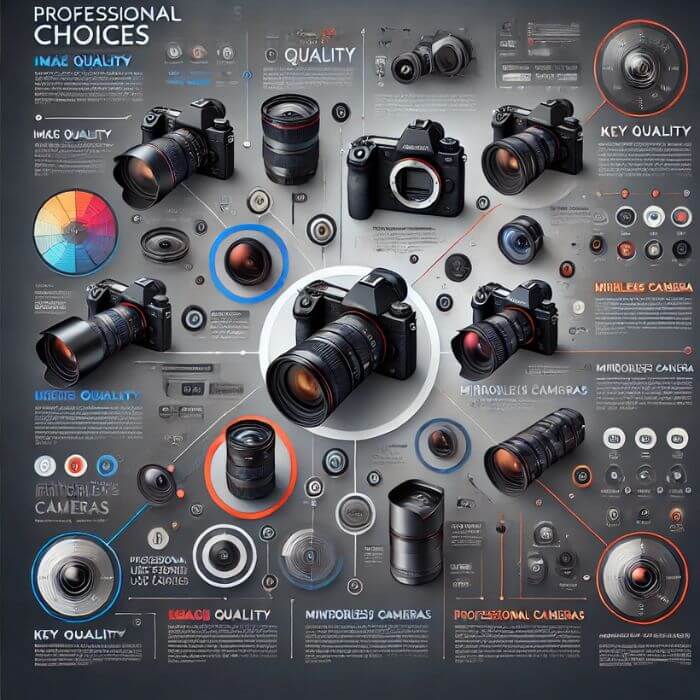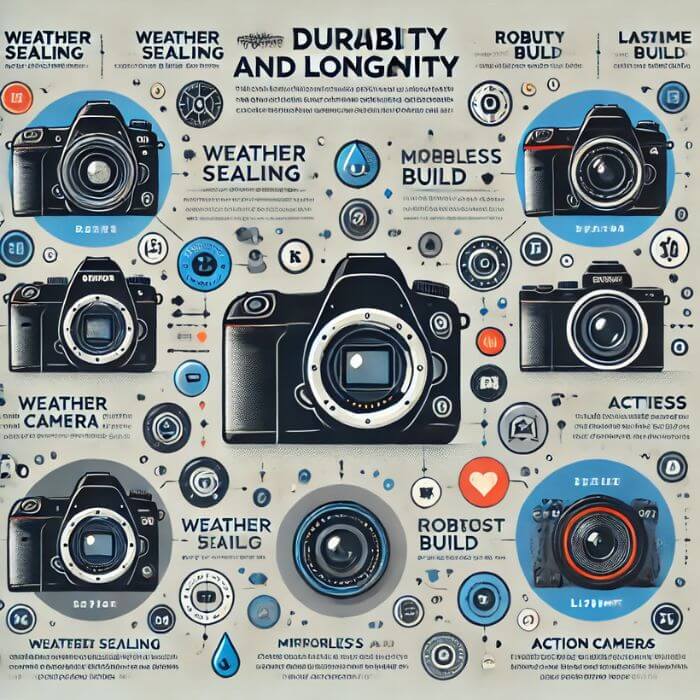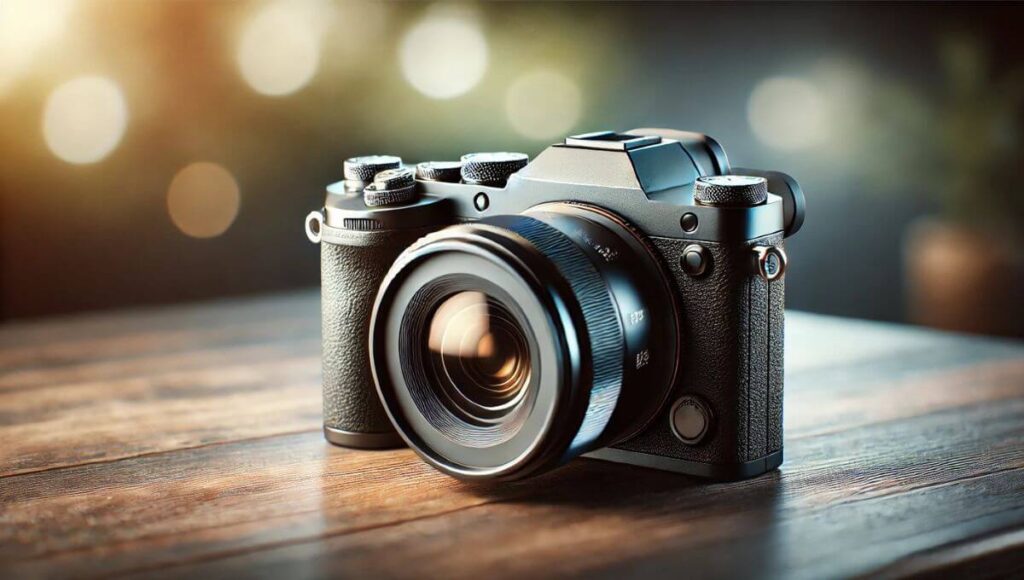Are Mirrorless Cameras Superior? Did you know that shooters are really loving mirrorless cameras these days? They have great features like high-tech image sensors and electronic viewfinders. They grew 30% more than DSLRs in 2019. There’s a lot of debate about whether compact cameras are better than DSLRs and Nikons. Let’s talk about what’s so appealing about these small, sleek cameras. They’re small, quiet, and have great viewfinders and focusing systems. We’ll also debunk some myths about DSLR cameras and Nikons. We’ll show you how to keep up with the changes in the world of digital photography, no matter what your skill level is.
Understanding the Difference Between Mirrorless and DSLR Cameras
Electronic Viewfinder
Mirrorless cameras like Nikon and Canon have electronic viewfinders that show you exactly how the image will come out. They don’t have a mirror to bounce light off the viewfinder like DSLRs do.
On the other hand, DSLRs like Nikon have optical viewfinders that don’t always show the true image. This can make it hard to tell if your photo is going to be too dark or blurry, especially when there’s not much light.
Image Quality Comparison: Mirrorless vs DSLR
Sensor Size and Resolution
Nikon and Canon have some great cameras. The size of the camera’s sensor is what makes the shots clearer and more detailed. Most of the time, larger sensors mean clearer, better photos. The high-resolution sensors of Nikon and Canon cameras allow you to take photos with a lot of information. Canon cameras also have larger sensors that allow them to take great shots. There are different models of cameras under both names with different numbers of megapixels. Images with more megapixels have a better resolution, which allows you to print larger photos or crop them without losing quality.
Lens Quality and Contrast Detection
The lens you use on your camera changes the look of the photo. Both mirrorless and DSLR cameras have different lenses that can be used for different types of photos. Brighter colors, better focus, and more clarity are all brought to an image by good lenses.
The autofocus system of mirrorless cameras is unique because it uses contrast detection to get focus in the image. This helps keep moving images sharp and clear.
If you compare it to DSLR cameras, they use a different autofocus method called phase detection. This helps keep moving objects in focus when you follow them quickly.
Video quality capabilities
When you compare their image quality, focus, and AF, you should compare the video features of these two types of cameras. Some of the newer compact cameras can record very good video and produce high-resolution videos with great dynamic range and autofocus.
Some models have more advanced stabilization systems that make movies smooth and steady even when they are shot handheld or while moving. On the other hand, entry-level DSLRs may not have some of the features that current mirrorless cameras do, such as the ability to record 4K video or use advanced focusing when recording video.
Size and Weight Considerations in Camera Choice

Portability Benefits
Many people choose mirrorless cameras because they are smaller, lighter, and have better autofocus than DSLRs. Then they are great for taking photos while traveling or on the road. Imagine taking pictures of great things while walking through a busy city with a small camera that you can carry in your pocket or bag. You don’t have to carry around big, heavy gear to record spontaneous events.
As an example:
- A small, lightweight digital camera with focus can be a great thing to bring with you on trips to capture beautiful scenery or real-life scenes.
- When they are wandering around cities, street shooters often like how mirrorless cameras are small and easy to use.
In any case:
- Some photographers prefer DSLRs because they are large and heavy, making them easier to hold and focus for long periods of time.
Ergonomics and Stability
For taking pictures, it’s important to know how big, heavy, and sharp a camera is. Some people prefer compact cameras that are small because they’re easy to hold and focus. Still, some people prefer larger DSLR cameras because they’re easier to hold and hold steady while taking pictures.
Think about it:
- If you like to have a firm grip on your gear or have larger hands, the ergonomic form of a DSLR with focus might be better for you.
- Professional shooters who use long telephoto lenses might like how DSLR bodies with larger sensors help them focus and balance.
On the other hand:
- Those who want a more flexible setup that allows them to quickly change settings on the go, like with mirrorless cameras.
Evaluating autofocus performance in mirrorless and DSLR cameras
Advanced autofocus systems
When you point and shoot with a mirrorless camera, autofocus technology can find and follow your eyes. This makes it easier to get clear shots of moving objects, like kids playing or pets.
Catching up with DSLRs
DSLRs used to be fast at focusing, but now compact cameras can do the same. New technology helps them focus quickly, so shooters don’t have to worry about taking too long to focus when they want to take pictures of fast-moving objects.
Varied performance across models
Autofocus works differently on different cameras. There are mobile cameras that are good at finding and focusing on the eye, and cameras that let you focus manually. Other cameras have other useful features. DSLRs also have different autofocus features, such as having more focus spots or focusing better in low light.
Mirrorless vs. DSLR Camera Advantages and Disadvantages
Advantages
A few things are better about mirrorless cameras than regular DSLR cameras. These are cameras that don’t have a mirror inside. They’re smaller and easier to carry, which is a big plus. Anyone who likes to take pictures on the go or in public will find this useful because they don’t have to carry around bulky gear.
Another great thing about digital cameras is that they don’t make any noise when taking pictures. On the other hand, DSLR cameras make noise due to reflections inside. With a compact camera, you can take pictures without making any noise that would bother other people. It is also possible for some compact cameras to record videos very well and focus on things while making movies.
Improved capabilities
Mirrorless camera systems have come a long way in these areas as well, but DSLR cameras are known for a larger range of lenses and better ergonomics for some photographers. Mirrorless camera users can now choose from a growing selection of high-quality lenses that can be used for a wide range of photography thanks to improvements in lens technology and adapters that allow you to use lenses from different manufacturers.
Modern mirrorless cameras also have ergonomic designs that make them suitable for a range of shooting styles and tastes. Many models have settings that can be changed and easy-to-use interfaces that improve the user experience and make it easier to hold the camera for long shooting sessions.
Disadvantages
There are some good things and some bad things to consider when it comes to mirrorless cameras. For some reason, the batteries don’t last as long as some other cameras. If you’re using a compact camera, you’ll need to bring extra batteries with you. An additional problem is that compact cameras don’t have as many lens options as other types of cameras. Although this is getting better as more manufacturers make lenses for mirrorless cameras.
Professional Choices in the Camera Industry

Professional Choices
There’s a lot of debate about whether compacts or DSLRs are better. Many professionals still prefer DSLRs because they’re reliable and easy to use. Professionals are increasingly switching to compact cameras, though, because they’re more flexible and have better technology.
Professional shooters prefer mirrorless cameras because they have many advantages. Since they’re small and light, they’re great for traveling or long shooting sessions. Mirrorless cameras have a synthetic viewfinder that shows you what the image will look like at the moment with the current exposure settings.
Additionally, mirrorless technology allows you to shoot without making noise, which can be useful in some situations where noise is a problem. Focus peaking on the screen helps you get the best focus while you’re taking a picture.
Technological Advancements
Professional shooters are increasingly using mirrorless cameras as the technology behind them continues to improve. Companies like Canon have invested heavily in developing mirrorless technology that is as good as standard DSLR technology.
Additionally, many new mirrorless cameras can record high-quality video, making them useful for professionals who need to take photos and videos. This gives photographers more choices.
Some compact cameras have touch screens that allow you to quickly change settings while shooting without having to press buttons or dials. This amount of control can be very helpful when you’re trying to get the perfect shot in changing environments.
Recommended Cameras for Different Photography Needs
Landscape Photography
Many times, DSLRs with high-resolution cameras are recommended. These cameras are great for capturing small details and taking clear, high-quality photos. DSLRs perform better in low light because their sensors are larger, which increases dynamic range. For example, the Nikon D850 has a 45.7-megapixel full-frame sensor that can capture beautiful landscapes with great clarity and detail.
While mobility is important, mirrorless cameras are also great for capturing landscapes. With its 61-megapixel full-frame sensor, models like the Sony Alpha a7R IV offer great clarity, making it perfect for capturing wide landscapes while keeping the weight down.
Sports and wildlife photography
Photographers often choose mirrorless cameras with fast burst rates and good autofocus for sports and wildlife photography because they can track moving subjects accurately. You can capture up to 15 frames per second with a camera like the Fujifilm X-T4. These cameras have advanced autofocus systems that make them great for capturing fast-moving action.
However, some professional photographers still prefer to use DSLRs for sports and wildlife photography because of how long the battery lasts and how well it works with a variety of lenses. The Canon EOS-1D X Mark III is a reliable camera that can handle tough conditions. It also comes with a wide telephoto lens for capturing sports or wildlife.
Portrait Photography
Depending on the photographer’s style and taste, both mirrorless and DSLR cameras can be used for portraits. Many mirrorless cameras have electronic viewfinders that preview exposure settings in real time. This allows shooters to make more precise adjustments before taking their shot.
On the other hand, many portrait photographers still prefer the standard optical viewfinders that come with DSLRs because they let you look directly through the lens without having to wait for electronic processing or deal with confusing digital overlays.
Durability and Longevity of Camera Types

Robust Build Quality
DSLRs are known for being well-made, which means they last a long time. They are built to last, making them suitable for shooting outdoors in all types of weather. DSLRs can handle rough settings without losing their performance because they are built to last and have plenty of weather sealing.
Mirrorless cameras have come a long way in terms of how long they last. While mirrorless cameras don’t have the same reputation for being as tough as DSLRs, newer models are built to last longer and have better weather sealing. For example, many high-end digital cameras now come with weather-resistant bodies that keep dust and water out when shooting outdoors.
If you take care of both types of cameras, they can last for many years. With improvements in technology and manufacturing methods, photographers can be sure that both DSLRs and mirrorless cameras will last a long time.
Longevity with proper care
No matter what type it is, it needs to be properly maintained. A camera will last longer if it is cleaned regularly to prevent dust build-up, stored safely when not in use, and handled carefully when not in use.
Battery life is an important factor that affects how long a camera lasts. Over time, both DSLRs and compact cameras have gotten better at this. These days, batteries can be used for a long time before needing to be charged or replaced.
Rethinking the Debate: Is Mirrorless Really Superior?
Size and Weight
DSLRs tend to be larger and heavier than mirrorless cameras. Because of this, they are easier to carry around, especially when traveling or shooting on the road. Since it does not have a mirror mechanism, it can be made smaller without losing image quality.
Popular mirrorless cameras like the Sony Alpha series and Fujifilm X-T4 are known for being lightweight, making them perfect for shooters who want to be mobile.
Technological Advancements
Full-frame mirrorless technology is better than standard DSLRs in several ways. Many of these cameras have computer viewfinders that show exposure, white balance, and depth of field in real time. Most of the time, they have high-tech focusing systems that are great at tracking moving subjects.
One example is the Panasonic Lumix S5, which has cutting-edge features like a 6K photo mode and high-speed autofocus. This shows that some mobile cameras are more technologically advanced than DSLRs.
Lens mount adaptability
Mount adapters allow compact cameras to work with a wide range of lenses, which is another big advantage. This makes it easier for shooters to use lenses made by different companies. For example, a photographer with a Canon RF-mount camera can use EF-mount lenses without any loss in functionality or image quality by using an adapter.
Additionally, some mirrorless camera mounts, such as the L-mount made by Leica, Sigma, and Panasonic, work with a variety of high-quality lenses.
Battery Life Considerations
Even with these advantages, compact cameras are still better than DSLRs in some ways, such as battery life. DSLR batteries generally last longer on a single charge than mirrorless batteries because their mechanical designs aren’t as complex as EVFs (electronic viewfinders), which use up a lot of power.
DSLRs also last longer because they’re mechanical rather than electronic, meaning they don’t rely on parts that can break or misbehave frequently under heavy use.
Summary
You’ve now learned more about mobile and DSLR cameras and thought about the pros and cons of each. From image quality and focusing to size, weight, and what pros want, you’ve seen how well each type holds up. But the main question still stands:
Is mirrorless really better? Think about the fact that the best camera for you is one that fits your desires and style. It’s not just about the specs; it’s also about how the camera feels in your hand and how it lets you record what you see. So, whether you choose a small, innovative digital camera or a reliable, long-lasting DSLR, choose a tool that helps you be creative and satisfies your love of photography.
Frequently Asked Questions
Should you get a DSLR camera or a compact camera?
Size, weight, and noise levels are all good with mirrorless cameras. One may be better than the other, though, depending on personal taste and shooting needs.
How do mirrorless cameras and DSLR cameras differ in terms of image quality?
Both types of cameras can take good pictures. The technology and specs they use make them different. Mirrorless cameras are better because their electronic viewfinders show you exposure settings in real time.
What are the most important things to consider when deciding between a DSLR and a compact camera based on weight and size?
They are usually smaller and lighter than DSLRs because they don’t have a large mirror system. This makes them easier to carry around without sacrificing image quality when you’re traveling or shooting on the road.
Which is better for autofocus: a compact camera or a DSLR camera?
Over the past few years, improvements in mirrorless technology have made DSLRs comparable to mirrorless cameras in terms of focusing performance. Both types now have fast and accurate focusing systems that can be used for a wide range of shooting styles.
What do professionals in the field think about compact cameras vs. DSLRs?
Many professionals prefer mirrorless cameras because they are small, quiet, and have many advanced features. But because there are so many lens choices, some people still prefer DSLRs for certain types of photography, such as sports or wildlife.


